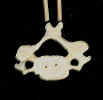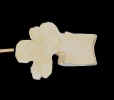

 Superior view, cervical vertebrae
Superior view, cervical vertebrae
 Superior view, cervical vertebrae
Superior view, cervical vertebrae
 Posterior view, thoracic vertebrae
Posterior view, thoracic vertebrae 
 Lateral view, lumbar vertebrae
Lateral view, lumbar vertebrae
The spinous (spinal) process projects in a posterior direction from the junction of the lamina of a vertebra. Each region has a characteristic shape. When we palpate vertebrae, it is the spinous process that we detect. We find that most cervical vertebrae have a bifid spinous process. The atlas lacks a spinous process and C7 is usually single. The thoracic vertebrae have long spinous processes that point in an inferior direction making them look like a giraffe. Remember the movie "Thoracic Park" with all the giraffes! The spinous process of the lumbar vertebrae are short, blunt, and project in a posterior direction. Muscles that help move the vertebrae attach to the spinous process. The spinous process also serves as a point of attachment for ligaments that stabilize the vertebral column. Lastly, one should note that the transition from one type of vertebra to the next is gradual so the first vertebra from one area looks much like the last vertebra from the preceding area.
COPYRIGHT
2007 by William C. Johnson II
ALL RIGHTS RESERVED!